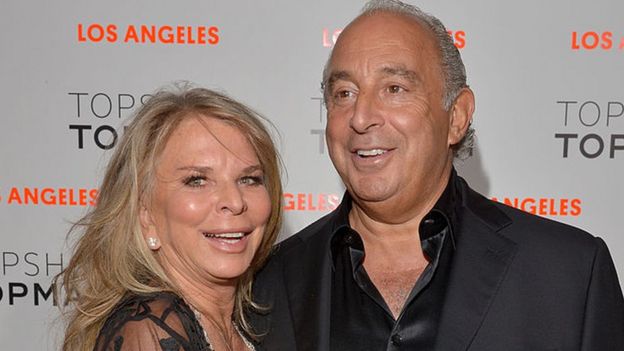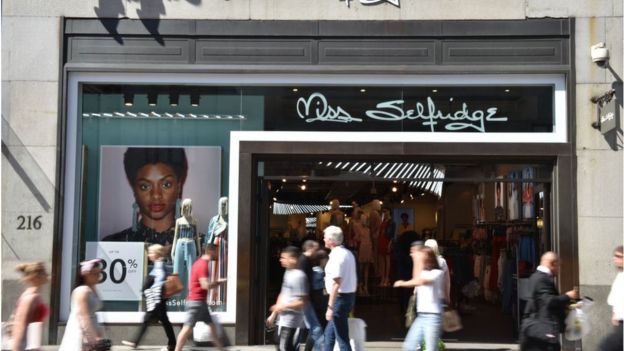High Street retail chain Arcadia claims to be in serious trouble, facing what it calls “significant liquidity issues”.
The answer, it believes, is a Company Voluntary Arrangement (CVA), a series of proposals to its creditors.
But critics say it raises as many questions as it answers and fails to address key branding and operational problems in the company.
Arcadia, owned by Lady Tina Green, the wife of chairman Sir Philip Green, says sales in its stores open more than a year fell 9% in 2018-19.
Earnings this year are expected to be £30m, compared with £219m two years ago.
Faced with fixed charges of £100m a year, the group says it is struggling to pay its way.
What does the CVA do?
A CVA is a renegotiation of terms with a company’s creditors as part of an insolvency procedure.
Arcadia’s CVA is a complicated, many-headed beast. For a start, it is not one, but seven arrangements relating to different parts of the group.
In theory, if one CVA fails, only one part of the company would go into liquidation. The rest would carry on trading.
In practice, Arcadia says that the companies are so interlinked that the whole group is unlikely to survive without all seven CVAs being approved.
The CVAs propose:
- The closure of 23 stores
- The renegotiation of rents on 194 stores
- Increasing net pension contributions over three years
- Investing £50m
- Giving landlords a 20% stake in Arcadia, but only if it is sold

What does it solve?
The company says it is paying £170m annually in rent. It estimates the leases are “over-rented” by 30% on average across the portfolio.
But most analysts believe that bill was coming down anyway.
Richard Hyman, an independent retail consultant, says Arcadia has been shrinking for years, closing stores as leases expired, and he said more were expected to close in the next two years for the same reason.
The CVA also proposes closing 23 stores, just 4% of Arcadia’s portfolio.
Mr Hyman said: “I find it hard to get my head round the idea that closing 23 stores in a group the size of Arcadia is going to make the difference between life and death.”
Ed Cooke, chief executive of retailers’ trade association Revo, says it demonstrates the problems are not as severe as Arcadia makes out: “There’s no suggestion here that Arcadia is really insolvent.”
Arcadia at a glance:
- Owner: Lady Tina Green, wife of Arcadia’ chairman, Sir Philip Green (67).
- Brands: Burton, Dorothy Perkins, Evans, Miss Selfridge, Outfit, Topshop, Topman and Wallis
- Outlets: 566 UK stores, but a total of 2,100 outlets including in-store concessions and franchises
- Countries: Predominantly UK, Ireland, the Channel Islands, Isle of Man, the US, Australia, the Netherlands and Germany
- Turnover: £1.8bn
- Employees: 18,000 in the UK
How did Arcadia get into trouble?
No-one disputes the company is in poor shape. It says it has suffered from the malaise affecting the whole High Street – higher business rates, the rising national living wage and the fall in the value of the pound, which has put up the cost of imported goods.
But Arcadia has problems of its own making, which a CVA does little to address and are largely to do with underinvestment.
Many date the problem to 2005 and the £1.2bn dividend paid out of Arcadia’s parent company, Taveta, to the Green family.
Chloe Collins, senior retail analyst at GlobalData, says Arcadia’s brands are tired and out of date: “Even Topshop, which used to be Arcadia’s star player, has lost appeal among fashion shoppers, thanks to tough competition from the likes of Zara, Primark and H&M, as well as online “pure plays” such as ASOS, PrettyLittleThing and boohoo.com.”

“Any attempt to pay for an increase in store standards would be spread too thinly to make up for years of underinvestment.”
Mr Cooke believes CVAs generally are being used to manipulate credit arrangements.
He said: “The management stays in place. the business stays the same. Not surprising the landlords are turning round and saying, ‘Hang on, why do I have to take a hit when this badly managed business is getting a break?'”
Will the creditors agree?
The CVAs have to be approved by 75% of the creditors. Without that approval, the company goes into liquidation.
In most CVAs, the creditors are usually banks or pension funds, so the landlords find themselves outvoted and their rental income cut. In this case, most of the seven CVAs are linked to the properties and the landlords’ votes will be the ones that count.
The landlords have also managed to persuade Arcadia to increase their potential stake in the company from 10% to 20%. The equity can only be realised if Arcadia is sold.

Clare Kennedy, director at consulting firm AlixPartners (which are not involved in Arcadia’s CVA), explained: “The landlord’s argument is that they should be compensated because they have been compromised in order to create value in the company proposing the CVA, and therefore they should benefit from any upside.”
Some of the landlords have been reported as wanting as much as a 40% stake in the company, but in the end, their approval of the CVA depends on how much of a cut they are prepared to take on their rental income.
PJT, the investment bank negotiating with Arcadia on behalf of a group of landlords, said in a statement: “There have been substantial improvements made to the CVA… which benefit all landlords, but there are still areas that need further clarity.”
What about employees’ pensions?
Creditors for one of the seven CVAs, which the company calls a “critical entity”, are not landlords but pension funds.
For the purposes of a CVA, the funds are treated as creditors under the control of the Pension Protection Fund (PPF).
Two years ago, Arcadia agreed to double the pension scheme deficit recovery contributions to £50m a year for 10 years, to repair a £1bn hole in the scheme.
Under the CVA, that £50m contribution would be halved.
But Lady Green has committed to pay £25m annually into the funds over three years, plus an additional £25m. On Friday, Frank Field MP urged Sir Philip Green to use his own money to support the pension fund.
So the CVA in effect cancels the recovery plan and replaces it with a slightly more generous one for three years, after which, according to a company spokesman, contributions are “to be renegotiated”.
According to John Ralfe, an independent pension consultant, there is some relief that pension contributions would be increased, since some analysts had expected a cut.
He said: “When we thought that the contributions were going to be cut, we thought that’s never going to be allowed. But with the increase in contributions, it stands a good chance of being approved.”
And after three years? Mr Ralfe is sanguine, adding that by then renegotiation was not unreasonable, since the pensions would have to be re-valued anyway.

